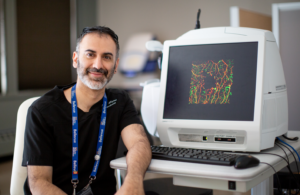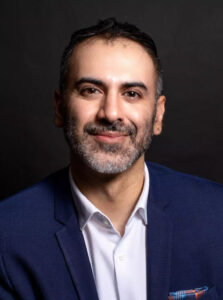
Dr. Laul in the clinic at University Eye Center of The State University of New York (SUNY) College of Optometry. Dr. Laul says you have the opportunity to set up relationships with other optometrists or clinics like theirs at SUNY to refer patients solely for imaging. Patients are then sent back to you for the rest of their care.
Keeping ocular disease patients in your practice without advanced instrumentation.
By Anupam Laul, OD, FAAO, Dipl. ABO
Nov. 8, 2023
The diagnosis and management of complex ocular diseases, such as glaucoma, usually involves advanced imaging technology that requires a significant investment by practice owners.
For those who aren’t ready to purchase many expensive devices, yet still want to manage ocular disease patients, setting up a co-management imaging relationship with a local practice offers benefits to both parties.
I’ve been fortunate to practice at the University Eye Center of The State University of New York (SUNY) College of Optometry, where I have access to advanced imaging devices, however, when I travel the country lecturing about glaucoma, I am often approached by optometrists who say lack of imaging equipment (usually due to cost) is a barrier for them, preventing them from managing glaucoma patients. In situations like this, often to their surprise, I tell them that many institutions (like us at SUNY) offer imaging-only services allowing optometrists and ophthalmologists to continue managing their patients, referring them out when imaging is needed.
At SUNY-UEC, imaging-only patients are connected through our referral center and are scheduled in imaging-only slots. When those patients arrive, they are greeted by a technician who performs the testing. Once complete, the patient leaves and is told the results will be sent to the referring provider and to schedule a follow-up with the referring doctor.
Setting Up Imaging Co-Management Relationships
Many optometry and ophthalmology practices, as well as teaching institutions, offer referral services for imaging only. Often, this information can be found on their website. If no information is listed online, consider reaching out to these institutions to ask if they offer imaging-only services.
Other Articles to Explore
Another great resource is local association meetings or CE/CME events. By talking to local providers, you can establish a relationship with a practice owner who has the needed imaging devices. Lastly, optical and device sales reps can also be a great resource. As part of their job, they travel practice to practice and know which offices have equipment. They can even offer you an introduction to the practice owner.
Documentation
When setting up an imaging co-management relationship, it is important to be clear about which services you need and whether you require interpretation of testing, or if you will interpret the scans yourself. This will determine how the testing is billed. A tentative diagnosis code is also needed to bill the test. 1 (See billing section below)
Be sure to include as much detail as possible to ensure you are getting the images you want. If you are interested in a lesion, include which eye, where it is located and the type of scan you would like. (ex. If you want an OCT scan of a retinal lesion, specify where it is [drawings are helpful] and what type of scan [5-line, radial scan, cube scan, OCT-A, etc.]) If possible, include recent exam notes. A common mistake is forgetting to include a recent manifest refraction when ordering a visual field test.
Billing And Coding
Reimbursement of diagnostic testing includes both performing the test AND the interpretation, however it doesn’t have to be performed by the same provider. 1 If you are sending your patients to an outside provider or facility for testing ONLY, with the use of modifiers, the referring provider can bill for the interpretation and the facility performing the testing can bill the technical component of performing the test. 1 The modifiers used are TC and 26. Each entity would bill the diagnostic test CPT code followed by the appropriate modifier.1
| MODIFIER: | DESCRIPTION |
| TC | “The technical component includes the provision of all equipment, supplies, personnel and costs related to the performance of the procedure” |
| 26 | “The professional component is outlined as a physician’s service, which may include technician supervision, interpretation of results and a written report.“ |
Source: AAPC
Accessed 8/21/2023
| Case Example:
Doctor A has been following a patient with a history of a benign pituitary tumor and requires a threshold visual field (CPT: 92083.) A local provider (Doctor B) has a visual field in his practice. Doctor A can refer the patient to Doctor B’s practice for visual field testing only and will see the patient once testing is complete. The patient will be referred to Doctor B’s office where a visual field will be performed, and the printout will be sent to Doctor A. Doctor A will receive the printout, analyze and interpret it, and she will discuss the results of the test with her patient. In this situation, Doctor B will bill CPT code 92083 with modifier TC and Doctor A would bill 92083 with modifier 26. |
Benefits To Patients & Providers
The obvious benefit of this practice modality is that your patients can continue seeing you. As their local provider, the convenience of your practice and the rapport you have built with them is why patients keep coming back to you. They feel comfortable in your care and would rather see you for their eye health management. Early stages of ocular conditions often only require monitoring or interventions within your scope and comfort level. Keeping patients in your practice is a win-win for both parties.
The testing facility or provider also benefits. The practice has invested a significant money in purchasing these devices, and there is often downtime when the devices are not use. By providing testing-only services to the local community the practice can recoup the cost of the initial purchase and add another revenue stream to the practice.
Keep Caring for Patients Who Need You
According to the National Institutes of Health, by 2030, 3.7 million Americans will have age-related macular degeneration, 4.3 million will have glaucoma and 11.3 million will have diabetic retinopathy. 2 This will require an all-hands-on-deck approach when managing ocular conditions. Incorporating the management of ocular conditions is a rewarding and much-needed addition to your practice.
References
- Chaplain. AAPC Knowledge Center. “When to Apply Modifiers 26 and TC” (https://www.aapc.com/blog/52001-when-to-apply-modifiers-26-and-tc/) Accessed 8/21/2023
- “Eye Disease Statistics” (https://www.nei.nih.gov/sites/default/files/2019-04/NEI_Eye_Disease_Statistics_Factsheet_2014_V10.pdf ) Accessed 8/24/2023
 Anupam Laul, OD, FAAO, Dipl. ABO is an Associate Clinical Professor at the State University of New York, College of Optometry. He is an attending doctor in the glaucoma service and runs the glaucoma micro-credential program at the college. To contact him: alaul@sunyopt.edu
Anupam Laul, OD, FAAO, Dipl. ABO is an Associate Clinical Professor at the State University of New York, College of Optometry. He is an attending doctor in the glaucoma service and runs the glaucoma micro-credential program at the college. To contact him: alaul@sunyopt.edu
Media contact: communications@sunyopt.edu or 212-938-5600.

























